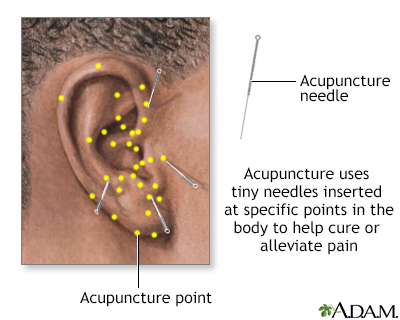| Pain relief - acupuncture |
Acupuncture is a treatment based on Traditional Chinese Medicine (TCM), a system of healing that dates back thousands of years.
Acupuncture gained the attention of the American public after President Nixon's trip to China in 1972. Traveling with Nixon was a New York Times reporter, James Reston, who received acupuncture in China after undergoing an emergency appendectomy. He was so impressed with the procedure's ability to relieve his postoperative pain that he wrote about his experience upon returning to the United States.
Acupuncture was formally recognized as part of mainstream medicine's range of healing options in 1997, when the National Institutes of Health issued a statement documenting its safety and effectiveness for a range of health conditions. Research comparing the effectiveness of acupuncture to other treatments -- including physical therapy, massage therapy, and standard medical treatment -- has not shown a clear benefit, however.
How does acupuncture work?
The effects of acupuncture are complex, and how it works is not entirely clear. Research suggests that the placement of needles, and other modalities used in acupuncture, may produce their complex effects on a wide variety of ways in the brain and the body. For example, it is theorized that stimulated nerve fibers signal the spinal cord and brain to release certain hormones responsible for making us feel better overall and, more specifically, feel less pain. In fact, a study using images of the brain confirmed that acupuncture increases our pain threshold, which may explain its ability to produce long-term pain relief.

As explained by TCM, there is a type of life force, or energy, known as qi (pronounced "chee") that flows through energy pathways in the body called meridians. Each meridian corresponds to one specific organ, or group of organs, that governs particular bodily functions. The proper flow of qi is thought to create health. An imbalance of qi (too much, too little, or blocked flow) results in disease. In acupuncture, needles are inserted at points along the meridians to restore balance to the qi. Acupuncture points, or the specific locations where needles are inserted, are places where the energy pathway is close to the surface of the skin.
What does an acupuncturist do?
In addition to asking questions, the acupuncturist may want to take your pulse at several points along the wrist and look at your tongue to observe its shape, color, and coating. The acupuncturist may also observe the color and texture of your skin, your posture, and other physical characteristics that offer clues to your health.
The acupuncturist then asks you to lie down on a padded examining table, and inserts the needles, twirling or gently jiggling each as it goes in. You may not feel the needles at all, or you may feel a twitch or a quick twinge of pain that subsides as soon as the needle is completely in. Once the needles are all in place, you rest for 15 - 60 minutes. During this time, you'll probably feel relaxed and sleepy and may even doze off. At the end of the session, the acupuncturist quickly and painlessly removes the needles.
How many treatments do I need?
For chronic back pain, one or two treatments a week for 1 to 2 months may be recommended.
What is acupuncture good for?
Acupuncture has been found to help some patients with chronic low back pain.
You can safely combine acupuncture with prescription drugs and other conventional treatments, but it is important for your primary care physician to be aware of and to monitor how your acupuncture treatment may be affecting your conventional therapies.
Should anyone avoid acupuncture?
Some physicians and practitioners may avoid treatment during pregnancy. If you have been seen by a particular practitioner prior to your pregnancy, however, it is generally safe to continue receiving treatment from that practitioner during your pregnancy.
Should I watch out for anything?
Be sure your acupuncturist uses only disposable needles. In addition, if your acupuncturist is qualified to prescribe herbs and would like you to take them as part of your treatment, first discuss this with your physician. Herbs are potent substances that can be harmful if you suffer from certain conditions. They can also interact with drugs you may be taking and cause side effects.
How can I find a qualified practitioner?
Most states require acupuncturists to be licensed and confer a title (LAc) that these acupuncturists can use to identify themselves. The American Academy of Medical Acupuncture (www.medicalacupuncture.org) can provide a list of licensed physicians in your area who are also trained to perform acupuncture. The American Academy of Orthopaedic Surgeons may also have a list of physicians who are trained in acupuncture (www.aaos.org). Your doctor may also be able to help.
The National Certification Commission for Acupuncture and Oriental Medicine certifies acupuncturists (Dipl Ac) and practitioners of Chinese herbal medicine (Dipl CH) upon passing a qualifying exam. To find certified practitioners, go to www.nccaom.org.
Does my medical insurance cover acupuncture treatments?
An increasing number of insurance providers and HMOs now cover all or part of the cost of acupuncture treatments, but these providers may have restrictions on the types of illnesses they cover. Check with your insurance company to see what your policy offers.
Reviewed By: Andrew W. Piasecki, MD, Camden Bone and Joint, LLC, Orthopaedic Surgery/Sports Medicine, Camden, SC. Review provided by VeriMed Healthcare Network. Also reviewed by David Zieve, MD, MHA, Medical Director, A.D.A.M., Inc.
